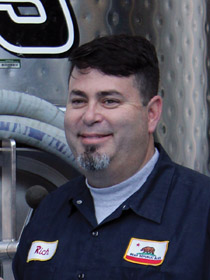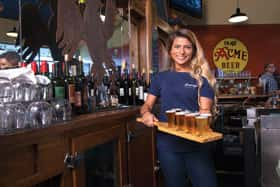“Beer is proof that God loves us and wants us to be happy.” Benjamin Franklin supposedly said that, but he really didn’t. Still, beer does make quite a few folks happy, which explains the 4,656 microbreweries in the United States. Mr. Franklin is also credited with “A penny saved is a penny earned.” And while he was a noted economic geek—how else do you think he got his mug on the $100 bill—even Ben would struggle making sense out of the craft beer industry.
Last year, small brewers like Fogbelt Brewing in Santa Rosa accounted for 12.2 percent of the beer produced in this thirsty country. But that also means 87.8 percent of the beer is produced by the likes of Anheuser-Busch InBev, MillerCoors and Heineken U.S. Hell, with the 2016 merger of ABInBev and SabMiller, that company will sell about one-third of the world’s total brew. Which begs the question, how in the name of Cascade Hops will all those thousands of microbreweries stay in business?
The answer, of course, is that they won’t. Last year, 68 microbreweries yelled Uncle, but 620 new ones sprung up to take their places. You can’t throw an empty growler in this country without hitting a microbrewery; 78.2 percent of the adults of drinking age live within 10 miles of a brewery.
Hello, Uber.
Small brewer volume grew by 13 percent, which makes sense looking at those new breweries. But at the same time, the total U.S. beer market experienced a little shrinkage, down 0.2 percent. As a country, we’re drinking more small brew, but less beer overall. Those numbers would suggest beer drinkers should expect some consolidation given the big breweries—with equally large pockets—and all the small brewers fighting for the hearts, minds, palates and dollars.
The traditional thinking has always been that the little guys stuck together against the long odds, kind of a “Kumbya” with yeast and fermentation tossed in: The micros versus the macros; David versus Goliath; the 49ers versus anybody in shoulder pads.
But the truth of the matter is, while Bud and the others are happy to pick off and buyout the occasional small brewer (and that brewer is happy to cash that check), the fight is looking more and more like little brewer versus little brewer.
Last year, the microbrewery industry generated $22.3 billion in revenues, according to the Brewers Association, a Colorado organization that tracks the industry. At first blush that’s a pretty fair size pie, but there are more than 4,600 folks with a fork in their hands waiting for their slice. And that figure is just a fraction of the whole beer market, where sales hit almost $106 billion. And there’s more than just a little evidence that suggests that the craft beer sector is edging dangerously close to maturation.
Maybe the clearest indication that change is coming to the little beer sector is the October announcement by San Diego-based Stone Brewing Company that it was streeting more than 50 of its employees. Stone, the 15th largest craft brewer in the country, has grown in some significant ways. It’s invested $75 million in a brewing facility in Virginia and another $25 million on a brewery in Berlin, but those expansions won’t pay off for a while. Meanwhile, the company said in a prepared statement, “Due to an unforseen slowdown in our consistent growth and changes in the craft beer landscape, we had to make the difficult decision to restructure our staff.”
It’s also worth noting that Craft Brew Alliance, a hybrid company that’s 34 percent owned by the makers of Budweiser and has craft beer brands such as Red Hook and Kona Brewing, laid off 50 percent of its brewery staff in Woodville, Wash., in October.
Marking their territory
 In January 2015, Lagunitas Brewing filed a trademark infringement lawsuit in federal court in San Francisco against Sierra Nevada over allegations that Sierra’s IPA Hop Hunter label looked too much like Lagunitas’ IPA label. Lagunitas scrapped the action just one day after it became the target of social media outrage, with head honcho Tony Magee announcing in a series of tweets the lawsuit would be pulled.
In January 2015, Lagunitas Brewing filed a trademark infringement lawsuit in federal court in San Francisco against Sierra Nevada over allegations that Sierra’s IPA Hop Hunter label looked too much like Lagunitas’ IPA label. Lagunitas scrapped the action just one day after it became the target of social media outrage, with head honcho Tony Magee announcing in a series of tweets the lawsuit would be pulled.
Consider this: In California, there are 710 small brewers as of September 2016, more than in any other state. And while lots of those brewers are simply serving and selling beer out of their own pubs, they still need to compete with each other for those drinking and dining dollars.
Those selling beer in retail outlets have to compete for a limited amount of shelf space that includes the major brands. This is a lot trickier than it sounds, because distributors often have their hands tied as to which brands they can represent. For years, distributors in California that handled Budweiser and its related brands weren’t allowed to carry competing beers. So when they went into a market or bar, only Bud products were getting off the trucks, making it tougher for other brands to find homes.
The same is often true when a bar or restaurant carries a major label of beer. Once again, let’s pick on Bud. Besides the King of Beer, the craft beers that were found on tap usually also belonged to Bud, like 10 Barrel Brewing, Shock Top Brewing and Goose Island.
On one hand, Bud is still dominant. But the King of Beer recently admitted it may be losing its legendary grip. Its own marketing data showed that 44 percent of drinkers between the ages of 21 and 27 have never tasted Beechwood aged Budweiser, despite the millions spent selling beer between innings on TV.
Just the same, big beer continues to make life tougher on little beer makers. “It’d be nice if all the cheating stopped,” says Brendan Moylan, who owns the Marin Brewing Company in Larkspur and Moylan’s in Novato. He’s been in the liquor and beer business for 39 years, serving as the beer buyer for the legendary Jug Shop in San Francisco at the ripe old age of 18.
He’s seated on a Moylan’s bar stool, nursing a Nitro Special Bitter, sneaking peeks at a soccer game (Ireland is playing somebody) and answering questions. “Everybody wants something. The distributors all have so many beers now; it isn’t like they’re going to go out of their way for your beer. Sometimes trying to get a handle in a bar can be hard, and you can’t really blame the owners—everybody’s coming at them offering something and there are only so many taps. And there’s only so much space in stores.”
For Moylan, retail sales are a big deal. While Marin Brewing generates just 25 percent of its income via retail, at Moylan’s that figure jumps to 75 percent. At Bear Republic Brewing Company, while its brew pub in Healdsburg does a great business, CoO and brewmaster Rich Norgrove reports retail sales make up the vast majority of the company’s business. “Now more than ever, this is a relationship business,” he says. “We want people to realize that Racer 5 IPA has been around a long time, and we aren’t chasing fads.”
It’s worth noting that the margins for craft brewers selling beer out of pubs, in growlers and otherwise, is much better than the beer going out the back door being sold via distributors, who take their cut. One traditional way in which businesses compete is on product price, which, for small brewers, can be a dangerous tactic. Traditionally, craft beer has been priced higher than mass produced beer, in part because it’s more expensive to brew smaller quantities of beer and in part because consumers are willing to pay more for something local or exotic.
But brewers that aren’t producing a lot of beer also have slimmer margins, which make discounting brew a riskier move. “Some guys are willing to take more risks. When we were all selling a 22-ounce bottle for $3.99, Lagunitas was selling theirs at $2.99—but they were able to make that work,” says Moylan. “They were willing to take on more risk.”
Working the system
Lagunitas is an interesting model. Brewing beer since 1993, the company built a fierce local following and transformed into a regional beer and a power in the microbrew industry. In 2015, Lagunitas sold a 50 percent share to Heineken in a move that gave the local brewer international reach, increased capital access and security.
While partnering with Heineken gave Lagunitas plenty of upside, it rubbed more than a few people in the industry the wrong way. The microbrew sector sees itself as fiercely independent, fighting the good fight for quality beer and against the creeping commercialization of all that’s good in the bubbles business. Those who welcome macro brewers like Heineken into the tent quickly don the label of sell-out.
It should be noted that Lagunitas’ Magee has insisted in plenty of interviews that nobody from the Dutch brewer has tried to fit him with a leash, and one trip to the Petaluma beer garden demonstrates that while the facility has changed, its beers and their variety have not. NorthBay biz asked Magee to talk a bit about his brewery and how the brand is transitioning, but he never got back to us.
Bear Republic’s Norgrove isn’t buying Magee’s insistence that Heineken will leave Lagunitas alone. “I think that sounds good, but at some point [Heineken] is going to look at a beer, and say its fine but couldn’t we make that differently? And what it will mean is ‘cheaper.’”
A Lagunitas-related entity, Lagunitas U.S. Holdings, has taken stakes in a trio of brewers, Southend Brewery and Smokehouse in Charleston, S.C., Independence Brewing in Austin, Texas and Moonlight Brewing Co. in Santa Rosa. The latter two will continue to operate as they are, with Lagunitas offering cash and support. Southend will be rebranded as a Lagunitas taproom.
Investments by craft brewers in other brewers is catching on, which could help smaller operations stay competitive. Boston Beer, one of the pioneering craft brewers, is now making loans to small brewers. Stone Brewing, a well-known San Diego craft brewer and maker of Stone IPA and Arrogant Bastard Ale, is establishing a $100 million fund to invest in smaller brewers and planning a taproom and a brewery in Napa.
Additionally, Lagunitas has plans to open taprooms in Portland and San Diego, but make them nonprofit centers, supplying staff and beer then letting organizations take them over to fundraise and—essentially the same thing that happens locally on Monday and Tuesday nights.
While many brewers are sailing along enjoying a marketplace that, in some ways, seems boundless, others are choosing to grow carefully. Russian River Brewing Company is breaking ground next spring on a new facility in Windsor, and it hopes to be brewing beer and open in fall 2018. Bear Republic is opening a place in the space where Latitudes was in Rohnert Park. “We think the location is great, about halfway between Russian River [Brewing Company] and Lagunitas,” Norgrove says. “We could be open next April.”
Natalie Ciluzro and her husband, Vinnie, are the wife-husband team that gives us the Plinys among other tasty beer. Natalie says the company is concentrating on the new place and keeping their current customers happy. Industry growth and increasing competition is causing some worry in the industry. “Something has to give,” she says. “The question is when and to what extent? This is unsustainable growth. There aren’t enough raw ingredients or shelf space to keep up at this pace.”
Her concerns are echoed by Norgrove. “We’re kind of stuck in the middle, because we’re one of the top 50 craft brewers in the country, so the big guys are trying to bite our head off or buy us, and the smaller guys are biting us in the ass,” he says, adding that one dangerous trends is the creation of exotic beers that can’t be produced in a consistent way. “There are beers out there that are grapefruit or pineapple, where you need specific hops, but what happens when you can’t get those?
At the time of our interview, Cilurzo was just back from the Great Beer Tasting in Denver, and the array of beers to taste was dizzying: “I saw many beers that were too weird for my tastes!”
Moylan thinks one way for smaller brewers to compete and look out for their best interest is to distribute their own product. “We did that years ago, and then thought if we turned it over we could concentrate on other parts of the business,” he says. “But there are so many beers out there now, by doing the distribution yourself, if you can afford it, you can have more say over where your beer goes.”
Cilurzo agrees that self-distribution is one possible answer for smaller brewers—that, and sticking to more traditional models, like brewpubs and tasting rooms.
And what about the idea of a bubble? Cilurzo discounts the danger a bit, “There’s always a danger, but I don’t think it will the 1990s. There are more craft beer drinkers now.”
Moylan says the idea of a bubble shouldn’t scare anybody. “Beer drinkers have never had it so good; a little consolidation won’t be the worst thing. Changes are on the way, and there’s going to be some fallout. The thing is, the brewers who stay in business are the ones who are doing one thing right now—brewing high quality beer—and not chasing the latest trends.”
Bubble or not, don’t look for changes out of Bear Republic. “We’re focused on brewing the best beer we can; we aren’t doing trendy stuff,” Norgrove says. “When we started out in this business, someday we wanted to be the biggest family brewer in [Sonoma] County. The day Lagunitas sold to Heineken, my dad called me up and said, ‘We did it!’ I didn’t understand what he was saying. ‘We’re now the biggest family brewer,’ he said. Now we just want to make beer that makes people happy.”
Too much brew?
There’s more than just a little evidence that suggest that the craft beer sector is edging dangerously close to maturation. Consider these points:
• Constellation Brands purchased San Diego-based Ballast Point Brewing Company for $1 billion last year. To put that into perspective, Lagunitas sold to Heineken for $500 million for a 50 percent stake.
• Sales growth in microbrews in the first half of the year was just 8 percent; the first time growth for a six month period hasn’t hit double digits.
• Even Walmart entered the microbrew business, paying Trouble Brewing in New York to create in-house brands for the discount giant.
• Bump Williams, a large consultant to the brew industry, says SKUs (stock keeping units) have grown in the craft sector from 2,274 to 11,833 since 2008.
• There’s now infighting over verbiage. Some in the industry insist locally produced beers are craft beer. Others say the term has been hijacked. “Call them small brewers,” advises one local brewer.
• While we’re talking about industry insiders, the “B” word is being whispered, as in “bubble.”
• The Smithsonian Institute is hiring a craft beer scholar.
To be fair, the Smithsonian is hardly a barometer of cutting edge commerce.
Bill’s Beer Tasting Tour
 It’s well established that Petaluma is the former egg capital of the world, as well as first city of wrist wrestling. While that’s certainly a proud (if not disjointed) heritage, today Petaluma’s simply regarded as a pretty nice place to live. But I’m here as a change agent. Henceforth, let’s refer to Petaluma as the North Bay Craft Beer Headquarters, the Beast of Brewing, the Major of Microbrew.
It’s well established that Petaluma is the former egg capital of the world, as well as first city of wrist wrestling. While that’s certainly a proud (if not disjointed) heritage, today Petaluma’s simply regarded as a pretty nice place to live. But I’m here as a change agent. Henceforth, let’s refer to Petaluma as the North Bay Craft Beer Headquarters, the Beast of Brewing, the Major of Microbrew.
And why not? Lagunitas Brewing Company calls North McDowell Boulevard home, with Petaluma Hills Brewing across the street soaking up the overflow. 101 North Brewing Company is also in Sonoma County’s southern-most city, and it’s joined by Dempsey’s Restaurant & Brewery. And while Taps Beer Co. & Kitchen isn’t a brewery, it has more beers on tap than Trump had excuses about his deep thoughts with Billy Bush.
So P-Town was the perfect spot for an extensive beer tasting. And after the magazine inexplicably signed off on underwriting this grand experiment in hops and double IPAs, I recruited an expert as my partner in crime, Petaluma resident Dan Lonkevich. He’s a journalist of the first stripe (check out his website (thepatentinvestor.com), a lover of the great outdoors and a Philadelphia Phillies fan.
What follows is an account of a fateful Fall Saturday when we boldly went forth to drink Petaluma’s best brews.
We began the day at Taps, where we had something to eat, laying a base for what came next. There were a number of cabin cruisers tied up on the basin and a half a dozen paddle boarders rippled towards us. After fortifying ourselves with wings, Brussel sprouts, sausages and fries, it was time to get into the liquid portion of our day.
We ordered all of the local brews on the menu, which was top heavy with foreign beers because of the upcoming Octoberfest. The first beer was 101 North Brewing Heroine, an Indian Pale Ale with a 7.2 percent alcohol content. I found it a little bitter, but Dan pronounced it not overly hoppy and austere. From the same brew house, we dove into High Gravity, a double IPA at 8.8 percent. This brew was smoother and Dan opined it was full of fruit, a bit heavy on the tongue and very hoppy.
At this point our server descended on us with more beer, a pattern that would carry on as we chased the afternoon. A Paid Vacation from HenHouse Brewing was the next across our palates. A Hoppy Saison is also referred to as a farmhouse beer, beyond that I can’t tell you much. Dan said it was not too sweet, the hops were right and it carried a little citrus. He also said it was a little creamy, which was not his mug of brew. I liked it fine, though not as much as the IPAs that had come before it. We also helped ourselves to a HenHouse IPA, which Dan compared it to a Scottish Ale, liking its character. In one breath he faulted the brew for being a little thin, and in the next said it was “a little dirty and naughty.” I’m not touching that.
Lagunitas’s Born Yesterday, a hoppy American pale ale, was next up. Unlike our afternoon, the beer was a little cloudy which Dan was quick to say was just fine: “You could drink a couple of these without getting filled up or toasted.”
To me, the toasted concept seemed a foregone conclusion (we’d recruited a designated driver for our outing). I liked Born Yesterday for its crispness, its ease of drinking and for its name. One of the traits that’s gotten out of hand is the cute names literally pouring out of craft brewers.
We ended our stay at Taps sipping Iron Springs 3 Tun Titan. A coffee stout from Fairfax in my neck of the woods, it was easily the heaviest brew we’d encountered. It took me back to nights spent in the Plough and Stars in San Francisco when as a freshman at SF State, when I’d pick a dark corner hoping to hide the fact I was 18 and looked 13. I learned to drink Guinness while they passed the hat for the IRA. Dan sang the praises of the 3 Tun Titan, loving its balance, round mouth feel and color.
We adjourned across the parking lot to Dempsey’s, where our server brought us a plank of tasters. The pilsner was light and simple. The Belgian Wit, an unfiltered brew bearing a little fruit, wasn’t the best that Dempsey’s had to offer. Dan found the Victory ESB too much like English beers, which aren’t his deal. I liked it, including the large proboscis.
The Red Rooster crowed, but not too loudly, and I liked the nutty aftertaste. Dan sipped his smiling, which could not be said for the Petaluma Gap IPA. “This isn’t my favorite beer here,” he said. But he got over it and plunged ahead into the Petaluma Strong Ale, “This isn’t overly hoppy, a very serviceable ale. It has interesting flavors.”
And then we were into the Boneshaker Double IPA. Dan held it to the sunlight poking through the trees and sipped. “This is it, a great beer. I like the roundness, the hops are fine.”
For our exit brew, it was the Ugly Dog Stout, a beer with a 6.7 percent alcohol content. Dan felt it was somewhat generic. It struck me as bitter, like a Dodger fan.
The last stop on our stumble and tumble was the mothership, the Lagunitas Tap Room. As the band presented some tasty blues, we tucked into a table in the bar. At this point, Lagunitas was akin to New Year’s Eve in that as the celebrants lurched and sped ahead, there was a nagging feeling that a decision in their not too distant future would be about the best place to get sick.
“Look at this place,” Dan said, “They’re minting money here.”
The fact that Lagunitas is doing so well let it craft a lot of original beers. On this day, there were eight seasonal offerings having nothing to do with their regular roster. In short order we had Tuberfest, Freakin’ Firkin, High West-ified Imperial Stout and a Little Sumpin Sumpin Ale.
Freakin’ is a weekly offering made in small batches, cask conditioned and uncarbonated. Dan was unimpressed as he felt the beer simply lacked much in the way of taste. Turbofest was hop heavy but tasted great. Nutty, with an aftertaste a little like a red ale. If Freakin’ and Turbofest were wandering a bit, the Imperial hit home. Aged in rye and bourbon barrels and mixed with Petaluma Coffee Company Dogfathers’s Roar beans, it was well balanced with almost a more chocolate than java influence. Dan disagreed, “Maybe a little too fussy.”
We finished with a Little Sumpin, a local favorite. It was fine, but by then, we weren’t. I squared the tab and made a few more notes before we departed the scene of the crime.
Author
-

Bill Meagher is a contributing editor at NorthBay biz magazine. He is also a senior editor for The Deal, a Manhattan-based digital financial news outlet where he covers alternative investment, micro and smallcap equity finance, and the intersection of cannabis and institutional investment. He also does investigative reporting. He can be reached with news tips and legal threats at bmeagher@northbaybiz.com.
View all posts




